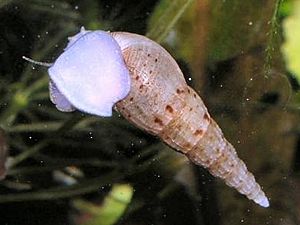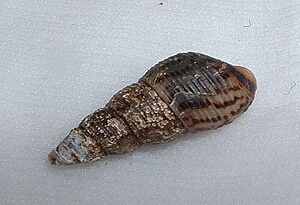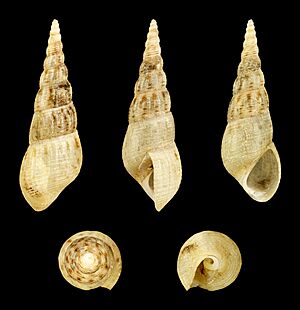Red-rimmed melania facts for kids
Quick facts for kids Red-rimmed melania |
|
|---|---|
 |
|
 |
|
| Conservation status | |
| Scientific classification | |
| Synonyms | |
|
See list |
The red-rimmed melania (Melanoides tuberculata) is a type of freshwater snail. People who keep aquariums often call them Malayan livebearing snails or Malayan/Malaysian trumpet snails (MTS). This snail has a special lid called an operculum that closes its shell. It's an aquatic gastropod mollusk from the family Thiaridae.
Its common name comes from the reddish spots on its greenish-brown shell. The scientific name Melanoides tuberculata is correct because Melanoides is a feminine word.
These snails are originally from northern Africa and southern Asia. However, they have spread by accident to many other warm parts of the world. They have also been introduced to heated aquariums in colder places.
Contents
What are Red-Rimmed Melania Snails?
Shell Features
The red-rimmed melania has a long, cone-shaped shell. It is usually light brown with rust-colored spots. It also has an operculum, which is like a trapdoor that can close the shell opening. In some places, like Israel, their shells are black or dark brown. This color probably helps them hide among the dark basalt rocks in the Sea of Galilee.
Most shells are about 20 to 36 millimeters (about 1 inch) long. Some special ones can grow up to 80 millimeters (over 3 inches) long! Their shells have 10 to 15 whorls, which are the turns or spirals of the shell.
Where Do These Snails Live?
These snails are naturally found in northern Africa and southern Asia.
- In Africa, you can find them in
- Algeria, Burundi, Democratic Republic of the Congo, Egypt, Eritrea, Ethiopia, Kenya, Libya, Malawi, Morocco, Mozambique, Namibia, Niger.
- South Africa (Eastern Cape, Free State, Gauteng, KwaZulu-Natal, Limpopo).
- Eswatini, Senegal, Sudan, Tanzania, Tunisia, Zimbabwe.
- In Asia, they live in
- Bangladesh, Cambodia, China, India (including Andaman Islands), Israel, Japan, Taiwan, Laos, Malaysia, Nepal, Saudi Arabia, Sri Lanka, Vietnam.
- Thailand.
Fossils show they lived in places like Gobero in Niger as far back as 6200–5200 BCE.
Spreading to New Places
Red-rimmed melania snails have spread to many new places around the world. This often happens because people who keep aquariums accidentally move them. These snails were brought to the United States for the aquarium trade as early as the 1930s.
They are now found in:
- Cuba.
- The United States (from Florida to Texas, and possibly expanding).
- Latin America (since the late 1960s), including Brazil.
- Netherlands, New Zealand, Venezuela.
- Dominica, Trinidad.
They can also live in warm indoor places like aquariums in greenhouses. This includes countries like:
- Czech Republic, Germany, Great Britain, Slovakia.
In the United States, large groups of these snails have been found. Sometimes there are as many as 10,000 snails in just one square meter! In some cases, these snails are thought to cause problems for native snail populations.
Their non-native homes in the United States include: Arizona, San Francisco Bay (California), Colorado, Florida, Hawai'i, Louisiana, Montana, North Carolina, Nevada, Oregon, Utah, Texas, and Fall River County (South Dakota).
Snail Life and Habits
This snail usually lives by burrowing into the ground. It is most active at night.
Where They Live
Even though they are freshwater snails, they can live in slightly salty water, called brackish water. They can handle water with a salinity of 32.5 parts per thousand.
They prefer warm climates, usually between 18 to 32 degrees Celsius (64 to 90 degrees Fahrenheit). They can even survive very high temperatures, up to about 50 degrees Celsius (122 degrees Fahrenheit). Knowing this helps people clean fishing gear to avoid spreading the snails to new places.
These snails can also survive in water with low oxygen levels. They are quite tough!
What They Eat
These snails mostly eat algae, which are tiny plant-like organisms.
Life Cycle and Reproduction
Red-rimmed melania females can reproduce without a male, which is called parthenogenesis. They also give birth to live young, meaning the eggs hatch inside the mother, which is called ovoviviparous. You can tell females apart because they have greenish parts inside, while males have reddish parts.
When conditions are good, females produce fertilized eggs. These eggs stay in a special pouch inside the mother until they hatch. A female snail can have between 1 and 64 babies in her pouch at one time. Snails can start having babies when they are as small as 5 to 10 millimeters long. They can have many babies over their lifetime. The babies are very tiny when born, only about 1.2 to 2.2 millimeters long.
Parasites and Health
Melanoides tuberculata snails can carry tiny living things called parasites. Some of these parasites can be harmful to humans or other animals. Scientists have found many types of trematode parasites in these snails. Some of these trematodes can cause sickness in humans if they get into the body, often through contaminated water or food.
These snails can also be hosts for a trematode parasite that infects an endangered fish species in Texas called the fountain darter. This shows how these snails can affect other animals in their environment.
Snails as Pests
Sometimes, red-rimmed melania snails can become a problem for farms. For example, they have been reported as pests on Chinese cabbage farms in Hong Kong.
In Aquariums
These snails are very common in freshwater aquariums. Some aquarium hobbyists see them as helpful because they eat algae and clean the gravel. Others see them as a nuisance because they can reproduce very quickly and take over an aquarium.
See also
- List of introduced molluscs species of Venezuela






